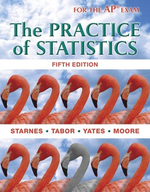Solution Found!
Technology for teaching statistics The Brigham Young University (BYU) statistics
Chapter 4, Problem 80(choose chapter or problem)
Technology for teaching statistics The Brigham Young University (BYU) statistics department is performing experiments to compare teaching methods. Response variables include students final-exam scores and a measure of their attitude toward statistics. One study compares two levels of technology for large lectures: standard (overhead projectors and chalk) and multimedia. There are eight lecture sections of a basic statistics course at BYU, each with about 200 students. There are four instructors, each of whom teaches two sections.45 Suppose the sections and lecturers are as follows: Section Lecturer 1 Hilton 2 Christensen 3 Hadfield 4 Hadfield Section Lecturer 5 Tolley 6 Hilton 7 Tolley 8 Christensen (a) Suppose we randomly assign two lecturers to use standard technology in their sections and the other two lecturers to use multimedia technology. Explain how this could lead to confounding. (b) Describe a better design for this experiment
Questions & Answers
QUESTION:
Technology for teaching statistics The Brigham Young University (BYU) statistics department is performing experiments to compare teaching methods. Response variables include students final-exam scores and a measure of their attitude toward statistics. One study compares two levels of technology for large lectures: standard (overhead projectors and chalk) and multimedia. There are eight lecture sections of a basic statistics course at BYU, each with about 200 students. There are four instructors, each of whom teaches two sections.45 Suppose the sections and lecturers are as follows: Section Lecturer 1 Hilton 2 Christensen 3 Hadfield 4 Hadfield Section Lecturer 5 Tolley 6 Hilton 7 Tolley 8 Christensen (a) Suppose we randomly assign two lecturers to use standard technology in their sections and the other two lecturers to use multimedia technology. Explain how this could lead to confounding. (b) Describe a better design for this experiment
ANSWER:Step 1 of 3
A lurking variable is a variable that has an important effect on the relationship among the variables in a study but is not one of the explanatory variables studied.
Two variables are confounded when their effects on a response variable cannot be distinguished from each other.
